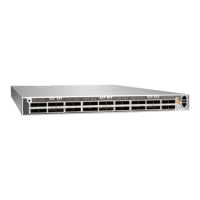Signal Loss in Mulmode and Single-Mode Fiber-Opc Cable
Mulmode ber is large enough in diameter to allow rays of light to reect internally (bounce o the
walls of the ber). Interfaces with mulmode opcs typically use LEDs as light sources. However, LEDs
are not coherent sources. They spray varying wavelengths of light into the mulmode ber, which
reects the light at dierent angles. Light rays travel in jagged lines through a mulmode ber, causing
signal dispersion. When light traveling in the ber core radiates into the ber cladding, higher-order
mode loss results. Together these factors limit the transmission distance of mulmode ber compared
with single-mode ber.
Single-mode ber is so small in diameter that rays of light can reect internally through one layer only.
Interfaces with single-mode opcs use lasers as light sources. Lasers generate a single wavelength of
light, which travels in a straight line through the single-mode ber. Compared with mulmode ber,
single-mode ber has higher bandwidth and can carry signals for longer distances.
Exceeding the maximum transmission distances can result in signicant signal loss, which causes
unreliable transmission.
Aenuaon and Dispersion in Fiber-Opc Cable
Correct funconing of an opcal data link depends on modulated light reaching the receiver with
enough power to be demodulated correctly.
Aenuaon
is the reducon in power of the light signal as it
is transmied. Aenuaon is caused by passive media components such as cables, cable splices, and
connectors. Although aenuaon is signicantly lower for opcal ber than for other media, it sll
occurs in both mulmode and single-mode transmission. An ecient opcal data link must have enough
light available to overcome aenuaon.
Dispersion
is the spreading of the signal over me. The following two types of dispersion can aect an
opcal data link:
• Chromac dispersion—Spreading of the signal over me, resulng from the dierent speeds of light
rays.
• Modal dispersion—Spreading of the signal over me, resulng from the dierent propagaon modes
in the ber.
For mulmode transmission, modal dispersion—rather than chromac dispersion or aenuaon—usually
limits the maximum bit rate and link length. For single-mode transmission, modal dispersion is not a
factor. However, at higher bit rates and over longer distances, chromac dispersion rather than modal
dispersion limits maximum link length.
An ecient opcal data link must have enough light to exceed the minimum power that the receiver
requires to operate within its specicaons. In addion, the total dispersion must be less than the limits
specied for the type of link in Telcordia Technologies document GR-253-CORE (Secon 4.3) and
Internaonal Telecommunicaons Union (ITU) document G.957.
67

